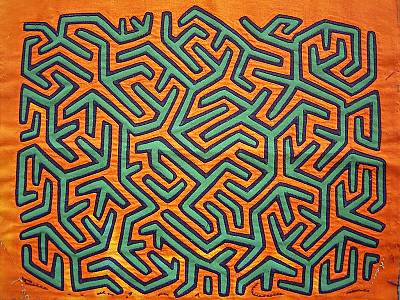- Colombia, Panama


Molas of Guna Women in Panama and Colombia

© “Mola (Nähkunstwerk)” by Stefan Laube is licensed under the public domain
1. ICH domains
Knowledge and practices concerning nature and the universe, traditional craftsmanship2. Short description
The indigenous communities of the Guna group live in the territories of Panama and Colombia. Guna indigenous women believe that there is a strong cultural interconnection between clothing and Guna identity. They traditionally wear gold rings in their noses that are beaded or gold necklaces, and decorate their forearms and legs with beaded winnis (bracelets). They cover their heads, and sometimes their faces, with red scarves with yellow print (muswe), wear wrap skirts made of a navy blue fabric decorated with patterns (sabured), shirts made of sleeves and collars of flowery fabrics, and finally, two hand-stitched cloth panels, one on the front and one on the back, called ‘Molas’.
The themes and colours used in the mola panels reflect the many interests of the Guna women, and emphasize the inclusion of everyday elements in their garments. The depiction of Guna cosmology and representations of Guna life cycle events on molas also sustains community identity, even for those women who do not wear molas every day, but produce them as commercial products. In addition to the important cultural aspects of the molas, the panels also have a symbolic meaning — they are an expression of identity and resistance to colonialism. Importantly, molas represent a source of income for families in Guna Yala. They have acquired a high commercial value and are exclusively manufactured by women and omeguiids (transgender men), who have become crucial contributors to household incomes.
Further information:
More information on the social context and techniques of Mola production can be found at the following links:
https://sanblas-islands.com/wp-content/uploads/2014/08/Guna-mola.pdf
https://sanblas-islands.com/Guna-indians/art/
Videos on the Guna community and mola production:
https://www.youtube.com/watch?v=6E4vxGxptO8 (in Spanish)
https://www.youtube.com/watch?v=n8jthUT1D2Y (in English)
3. Link with sustainable development
Income garnered from the selling of molas in Guna Yala is an example of how safeguarding intangible cultural heritage can contribute to the local economy and reduce poverty in communities. Of no less importance, the commercialisation of molas contributes to gender equality through female empowerment and the full participation of women at all levels of decision-making in local political, economic and public life. The production of molas, based on traditional knowledge and practices, has contributed to this equitable gender relations and economic growth, which thus reflects both the aims of SDG 5, to achieve gender equality and empower women and girls (and transgendered men) and SDG 8, focusing on decent work and inclusive economic growth.
4. Questions for reflection
In 2001, the Guna registered molas as an indigenous collective property right, (Panama Law No. 20 (June 26, 2000) ‘on a special intellectual property regime for the collective rights of indigenous communities, for the protection of their cultural identities and traditional knowledge’. See: http://www.wipo.int/wipo_magazine/en/2005/06/article_0005.html) which increased the value of the pieces and protected molas from unauthorized copying. The rise in tourism in Guna Yala has also boosted sales of molas and other tourism related businesses. However, demands from tourism can also lead to decontextualisation and shift mola production towards market preferences, rather than reflecting the elements that give identity to the Guna people. This may consequently weaken the traditional knowledge associated with the production of molas.
How can such risks be mitigated for ICH manifestations in commercialising products or processes?
What is the best way to balance commercialisation and the traditional knowledge and practice of the craft?
What can States do to protect such intellectual property, especially if the manifestations occur in two different countries?